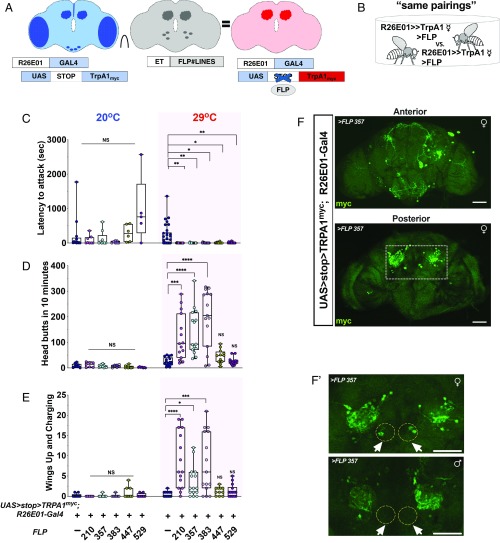Fig. 2.
Female aggression is driven by a subset of neurons. (A) Intersectional strategy used to isolate neurons in the female brain. et-FLP was used in combination with the R26E01-Gal4 driver and UAS > stop > TrpRPA1myc. (B) Schematic of assay in which a female FLP#∩R26E01 was paired with another female of the same genotype in a fighting chamber at 20 °C or 29 °C. (C) Fighting latencies (Kruskal–Wallis, H = 27.05, P = 0.0007; n = 15 to 20 flies) were significantly shorter for 210FLP∩R26E01 (**P = 0.0042), 357FLP∩R26E01 (**P = 0.0060), 383FLP∩R26E01 (*P = 0.0147), 447FLP∩R26E01 (**P = 0.0159), and 529FLP∩R26E01 (**P = 0.0094) flies compared with controls. Dunn’s multiple-comparison post hoc tests determined these values. (D) Number of head butts in the 10 min after the initial head butt (Kruskal–Wallis, H = 61.15, P < 0.0001; n = 12 to 17 pairs) during thermogenetic activation of R26E01-Gal4 intersected with FLP#∩R26E01-positive neurons. 210FLP∩R26E01 (***P = 0.0007), 357FLP∩R26E01 (****P < 0.0001), and 383FLP∩R26E01 (****P < 0.0001) pairings showed more head butting compared with control pairings. Dunn’s multiple-comparison post hoc tests determined these values. (E) An increase in the number of times flies displayed wings up and charging during the 10-min fight (Kruskal–Wallis, H = 39.34, P < 0.0001, n = 11 to 17 pairs). Fight pairings 210FLP∩R26E01 (****P < 0.0001), 357FLP∩R26E01 (*P = 0.0261), and 383FLP∩R26E01 (***P = 0.0002) held up their wings during charging more often compared with control pairings. Dunn’s multiple-comparison post hoc tests determined these values. (F) Confocal Z-stack images of intersectional expression of TrpPA1myc in female brains of R26E01-Gal4 with 357FLP∩R26E01. (F′) A male brain and female brain immunostained with anti-myc antibody (green). (Scale bars: 50 µm.) Data in C to E: center line, median; boxes, first and third quartiles; whiskers, range. Circles represent individual values. NS, not significant at P > 0.05. Aggressive behaviors were measured over a 40-min period.

